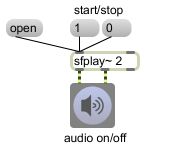Open a sound file and play it.
This shows an extremely bare-bones program for audio file playback.
1. Click on the speaker button to turn audio on.
2. Click on the word “open” to open a dialog box that allows you to select a soundfile. (In the dialog, select a WAVE or AIFF file and click Open.)
3. Click on “1” to start playing (“0” to stop playing).
The sfplay~ box is a normal MSP object. It performs an audio task: it plays sound files from disk and sends the audio signal out its outlets. The number 2 after sfplay~ is an ‘argument’, giving the object some additional information: that it should play in stereo, and thus should have two audio signal outlets. (The third outlet will send a notifying message when the soundfile is done playing, but this program doesn’t use that outlet.) The speaker button (a.k.a. the ezdac~ object) is a ‘user interface object’. It allows the user to interact with the program (in this case, by clicking on it with a mouse) and it performs a task (to turn audio on and off, and to play whatever audio signals it receives in its inlets as long as audio is turned on). Notice that the patch cords between the outlets of sfplay~ and ezdac~ are yellow and striped; that indicates that what is being passed between those objects is audio signal. The open, 1, and 0 objects are ‘message boxes’. They are user interface objects, too. When clicked upon, they send the message they contain (in these cases, the word ‘open’ or the number 1 or 0) out the outlet to some other object. These messages are ones that sfplay~ understands. The plain black patch cord indicates that what is passed between these objects is a single message that happens at a specific instant in time rather than an ongoing stream of audio data. The words ‘start/stop’ and ‘audio on/off’ are called comments. They don’t do anything. They’re just labels to give some information.

